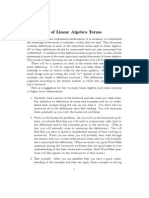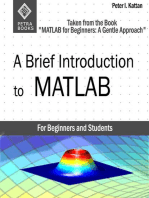Rational Numbers - Multiplying Rational Numberspdf
Rational Numbers - Multiplying Rational Numberspdf
Uploaded by
api-261958886Copyright:
Available Formats
Rational Numbers - Multiplying Rational Numberspdf
Rational Numbers - Multiplying Rational Numberspdf
Uploaded by
api-261958886Original Title
Copyright
Available Formats
Share this document
Did you find this document useful?
Is this content inappropriate?
Copyright:
Available Formats
Rational Numbers - Multiplying Rational Numberspdf
Rational Numbers - Multiplying Rational Numberspdf
Uploaded by
api-261958886Copyright:
Available Formats
!"#$%&"'()*+,-./((0*'#$1'2$&3(!"#$%&"'()*+,-.
/( (
Integer M ultiplication
((((((((((((((((((((
Unit 5
We can use the rules for multiplying rational numbers to solve simple and complex math problems. Let's
look at several tables which will show us how these rules are use.
Rule 1:
T he product of a positive integer and a positive integer is a positive integer.
Rule 2:
T he product of a negative integers and a negative integer is a positive integer.
Rule 3:
T he product of a positive integer and a negative integer is a negative integer.
Rule 4:
T he product of a negative integer and a positive integer is a negative integer.
Look at the following tables, the integers being multiplied, and the rules used to multiply them.
Remember: when two numbers are next to each other, separated by parenthesis, it means that they are
being multiplied.
Example 1: Find the product of each pair of integers.
Multiplying Integers
Integers
Product
Rule Used
21
Rule 1
21
Rule 3
21
Rule 4
( 7) ( 3) =
( 7) ( 3) =
( 7) ( 3) =
( 7) ( 3) =
Rule 2
21
Example 2: Find the product of each pair of integers.
Multiplying Two Integers
Integers
Product
Rule Used
( 8) ( 4) =
32
Rule 1
22
Rule 3
42
Rule 4
( 11) ( 2) =
( 14) ( 3) =
-
( 9) ( 5) =
Rule 2
45
In each of the above examples, we multiplied two integers by applying the rules at the top of
the page. We can multiply three integers, two at a time, applying these same rules. Look at the
example below:
Example 3: Find the product of each set of integers.
Multiplying Three Integers
Integers
Product of First Two Integers and the Third
( 16) ( 5) =
( 27) ( 2) =
( 12) ( 5) =
( 5) ( 3) ( 2) =
( 8) ( 2) ( 5) =
( 6) ( 3) ( 4) =
( 9) ( 3) ( 2) =
( 4) ( 3) ( 5) =
Product
80
( 18) ( 4) =
72
( 15) ( 2) =
30
54
60
Summary: Multiplying two integers with like signs yields a positive product, and multiplying
two integers with unlike signs yields a negative product. We can multiply three
integers, two at a time, applying these same rules.
(4#'"&#$5(6&$%&(7%&8-.-&5-(9-"5:-.(;*''-#$&((
(<<<=#-"5:-.,*''-#$&=%.3(((
(((((>"3-(D(%8(?@(
!"#$%&"'()*+,-./((0*'#$1'2$&3(!"#$%&"'()*+,-./( (
((((((((((((((((((((
M ultiplying Rational Numbers
~
Student Practice Worksheet
Name____________________________________________Date______________Grade___________
Answer the following questions about multiplying rational numbers:
Find the product of the rational numbers.
1.
2.
3.
4.
5.
6.
7.
8.
9.
10.
11.
12.
13.
14.
15.
16.
17.
18.
19.
20.
21.
(4#'"&#$5(6&$%&(7%&8-.-&5-(9-"5:-.(;*''-#$&((
(<<<=#-"5:-.,*''-#$&=%.3(((
(((((>"3-(E(%8(?@(
You might also like
- Maths Quest 7 AlgebraDocument36 pagesMaths Quest 7 AlgebraFathima Nusrath100% (1)
- DISCRETE MATH MODULE 13 Fundamental Principles of CountingDocument26 pagesDISCRETE MATH MODULE 13 Fundamental Principles of CountingJayNo ratings yet
- Function and Relations (Part 1)Document23 pagesFunction and Relations (Part 1)Siyamthanda MpingaNo ratings yet
- 1130 Chapter 3Document15 pages1130 Chapter 3jnando101No ratings yet
- Module 4Document10 pagesModule 4Christian BesinNo ratings yet
- Math 4 Quarter 3 Week 5Document29 pagesMath 4 Quarter 3 Week 5Honeylyn SM AranetaNo ratings yet
- Mit18 05 s22 Class01-Prep-BDocument9 pagesMit18 05 s22 Class01-Prep-Bankitjoiya123No ratings yet
- Imran Rasool Bbe-1586Document9 pagesImran Rasool Bbe-1586M shahzaibNo ratings yet
- Quarter 1 Week 1 & 2 Mathematics 7: Lesson 3: Absolute Value of A NumberDocument10 pagesQuarter 1 Week 1 & 2 Mathematics 7: Lesson 3: Absolute Value of A NumberDevie Anne BiscarraNo ratings yet
- Counting and Sets Class 1, 18.05 Jeremy Orloff and Jonathan Bloom 1 Learning GoalsDocument9 pagesCounting and Sets Class 1, 18.05 Jeremy Orloff and Jonathan Bloom 1 Learning Goalssubramanyam62No ratings yet
- GMAT Quant Concepts & FormulaeDocument31 pagesGMAT Quant Concepts & FormulaeAristotlePrep100% (1)
- BPJ Lesson 8Document4 pagesBPJ Lesson 8api-307093783No ratings yet
- Note - Math AA HL Year 1 GuideDocument124 pagesNote - Math AA HL Year 1 GuidemimiNo ratings yet
- Math4 Q3 Module3 Week3Document4 pagesMath4 Q3 Module3 Week3ALLYSSA MAE PELONIANo ratings yet
- HW 2 Online Dfadfa Fadmsklfm Mlfmad Mlkfadmf FadDocument4 pagesHW 2 Online Dfadfa Fadmsklfm Mlfmad Mlkfadmf Fadkukhunga2No ratings yet
- Integers & Pythagoras' TheoremDocument12 pagesIntegers & Pythagoras' TheoremMasdianahNo ratings yet
- 01 RationalNumbersDocument11 pages01 RationalNumbersSusana Salas100% (1)
- Kim Kim Kim KimDocument6 pagesKim Kim Kim KimcebusendaiNo ratings yet
- The Number System and Operatio NS.: Natural NumbersDocument11 pagesThe Number System and Operatio NS.: Natural Numbersapi-282778732No ratings yet
- AlgorithmsDocument20 pagesAlgorithmsninang26No ratings yet
- Algorithm AddDocument6 pagesAlgorithm AddFatin Faridah ShaharinNo ratings yet
- Data Science - ProbabilityDocument53 pagesData Science - ProbabilityNguyen Van TienNo ratings yet
- It161 Lab-11Document9 pagesIt161 Lab-11ATHAK YADAVNo ratings yet
- Worksheet On Algebraic Fractions (Multiplication and Division)Document26 pagesWorksheet On Algebraic Fractions (Multiplication and Division)mathsman9No ratings yet
- ReportDocument10 pagesReportahmed.elragal02No ratings yet
- Tutorial 1Document6 pagesTutorial 1Samia ElsayedNo ratings yet
- AlgorithmDocument8 pagesAlgorithmsaurab_baraikNo ratings yet
- Linear Algebra TermsDocument35 pagesLinear Algebra Termsbluebird818No ratings yet
- De Nitions of Linear Algebra TermsDocument21 pagesDe Nitions of Linear Algebra Termsderp2ooNo ratings yet
- De Nitions of Linear Algebra TermsDocument28 pagesDe Nitions of Linear Algebra Termsderp2ooNo ratings yet
- 1 8 Subsets of Real NumbersDocument15 pages1 8 Subsets of Real Numbersapi-233527181No ratings yet
- Number - System Study - NotesDocument13 pagesNumber - System Study - NotesladkibadianjanihaiNo ratings yet
- The Trachtenberg Speed System of Basic MathematicsDocument11 pagesThe Trachtenberg Speed System of Basic MathematicsGaurav Jagnani100% (1)
- Algebra Lesson 1Document11 pagesAlgebra Lesson 1Angelica CabalseNo ratings yet
- Summation NotationDocument6 pagesSummation NotationxsilversaphiraxNo ratings yet
- Module - Operations of IntegersDocument15 pagesModule - Operations of IntegersQuerubin Macadangdang100% (1)
- HCF LCM Squre RootsDocument0 pagesHCF LCM Squre RootsCh Saqib NazirNo ratings yet
- Second Exam 2022 - 2023 (W - Solutions) - V1Document8 pagesSecond Exam 2022 - 2023 (W - Solutions) - V1butarros123No ratings yet
- Math Quick Review: Addition Rules For Integers Type of Numbers Operation Result ExampleDocument3 pagesMath Quick Review: Addition Rules For Integers Type of Numbers Operation Result ExampleChristine VictorioNo ratings yet
- Alexander Golovnev, Alexander S. Kulikov, Vladimir v. Podolskii, Alexander Shen - Discrete Mathematics For Computer Science-Leanpub - Com (2022) - 4Document56 pagesAlexander Golovnev, Alexander S. Kulikov, Vladimir v. Podolskii, Alexander Shen - Discrete Mathematics For Computer Science-Leanpub - Com (2022) - 4Chirag SutharNo ratings yet
- Math 8 Unit 3Document22 pagesMath 8 Unit 3api-114939020No ratings yet
- Lesson 8-Basics of Counting, Permutations & CombinationsDocument10 pagesLesson 8-Basics of Counting, Permutations & CombinationsUdeshika WanninayakeNo ratings yet
- Adding RulesDocument8 pagesAdding Rulesanne_mohdNo ratings yet
- Adding and Subtracting IntegersDocument11 pagesAdding and Subtracting IntegersKenny TothNo ratings yet
- The Real and The Complex Number SystemDocument28 pagesThe Real and The Complex Number Systemmessay zewduNo ratings yet
- MAT214ALecture3 1Document5 pagesMAT214ALecture3 1goflux pwnsNo ratings yet
- Mathematics RulesDocument14 pagesMathematics RulesAyas uddinNo ratings yet
- Solve EQUATION MATHCAD Gauss EliminationDocument14 pagesSolve EQUATION MATHCAD Gauss Eliminationsammy_bejNo ratings yet
- Matrices with MATLAB (Taken from "MATLAB for Beginners: A Gentle Approach")From EverandMatrices with MATLAB (Taken from "MATLAB for Beginners: A Gentle Approach")Rating: 3 out of 5 stars3/5 (4)
- A Brief Introduction to MATLAB: Taken From the Book "MATLAB for Beginners: A Gentle Approach"From EverandA Brief Introduction to MATLAB: Taken From the Book "MATLAB for Beginners: A Gentle Approach"Rating: 2.5 out of 5 stars2.5/5 (2)
- GCSE Mathematics Numerical Crosswords Foundation Written for the GCSE 9-1 CourseFrom EverandGCSE Mathematics Numerical Crosswords Foundation Written for the GCSE 9-1 CourseNo ratings yet
- MS Excel Bible, Save Your Time With MS Excel!: 8 Quality Excel Books in 1 PackageFrom EverandMS Excel Bible, Save Your Time With MS Excel!: 8 Quality Excel Books in 1 PackageNo ratings yet
- Test CorrectionsDocument2 pagesTest Correctionsapi-261958886No ratings yet
- 8 G ProjectDocument3 pages8 G Projectapi-261958886No ratings yet
- 8th Grade Math Final Study Guide Jan 2015Document2 pages8th Grade Math Final Study Guide Jan 2015api-261958886No ratings yet
- Quotient of PowersDocument3 pagesQuotient of Powersapi-261958886No ratings yet
- Power of PowerDocument3 pagesPower of Powerapi-261958886No ratings yet
- Modeling IntegersDocument3 pagesModeling Integersapi-261958886No ratings yet
- Additive InverseDocument1 pageAdditive Inverseapi-261958886No ratings yet
- Fraction Decimal Percent ConversionsDocument1 pageFraction Decimal Percent Conversionsapi-261958886No ratings yet
- Honors Algebra Syllabus Orellana 14-15 2Document4 pagesHonors Algebra Syllabus Orellana 14-15 2api-261958886No ratings yet
- Algebra Syllabus Orellana 14-15 2Document4 pagesAlgebra Syllabus Orellana 14-15 2api-261958886No ratings yet
- Algebra Readiness Syllabus Orellana 14-15Document4 pagesAlgebra Readiness Syllabus Orellana 14-15api-261958886No ratings yet






































































